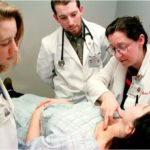Ranked List of the Best Pre-Med Schools
What’s Covered:
- What is Pre-Med?
- Ranked List of Best Pre-Med Schools
- Picking a College as a Pre-Med: Factors to Consider
- Do You Have a Balanced School List?
Are you thinking about a career in medicine? It’s never too early to start preparing. The undergraduate college you choose plays a critical role in shaping your path to medical school and beyond. From academic rigor to research opportunities and advising support, your undergraduate experience can have a lasting impact on your success in the field.
See the complete list of top schools for pre-med students.
What is Pre-Med?
Pre-med may sound like a major, but it’s actually a college track that is made up of specific courses that you agree to take as prerequisite courses for medical school. Students can major in any field they want, but will have to take all of the required pre-med courses so that they stay on the pre-med track. Most pre-med students choose to major in something related to the medical field, such as biology or chemistry. Learn more about some of the best majors for pre-med students.
If you know that you want to be a medical doctor while you’re still in high school, you should look for colleges that will prepare you well for the profession. As you sift through potential colleges, keep in mind that your pre-med experience should ultimately set you up for a bigger goal: med school. An ideal college will have a pre-med track that can guarantee success in these four crucial aspects of a medical school application:
- Getting a high GPA
- Scoring well on the MCAT
- Engaging in meaningful activities and building a strong resume
- Completing the application (including rec letters and essays) and interview, though you should note that these are mostly independent of the undergraduate school you choose
Want to know your chances at the schools you’re applying to? Calculate your admissions chances right now and understand your odds before applying.
The Best Pre-Med Schools, Ranked
Note: Seven- or eight-year BS/MD programs, such as Brown’s PLME, are not included. Rankings are based on four key pre-application elements: GPA, MCAT prep, patient care experience, and research experience.
1. Harvard College
Location: Cambridge, MA
Acceptance Rate: 4%
Middle 50% SAT/ACT: 1510-1580 SAT/34-36 ACT
Undergraduate Enrollment: 7,038
In general, the medical school acceptance rate for Harvard graduates ranges from 85% to 90%—and approximately 92% to 95% for applicants with GPAs above 3.5. With some of the world’s smartest students, a great location among the numerous Boston medical facilities, and groups such as the Harvard Premedical Society, Harvard offers a plethora of invaluable resources to its pre-med students. The college is also known for its rampant grade inflation, which is good news for your GPA.
Learn more about Harvard and what it takes to get accepted.
2. Duke University
Location: Durham, NC
Acceptance Rate: 7%
Middle 50% SAT/ACT: 1520-1570 SAT/34-35 ACT
Undergraduate Enrollment: 6,488
Duke, while very academically competitive, consistently boasts a high medical school acceptance rate. Students at Duke also have access to a wide variety of resources, from personalized advising to research and internship opportunities provided by Durham and Duke’s prestigious School of Medicine.
Learn more about Duke and what it takes to get accepted.
3. University of Pennsylvania | UPenn
Location: Philadelphia, PA
Acceptance Rate: 5%
Middle 50% SAT/ACT: 1510-1570 SAT/34-36 ACT
Undergraduate Enrollment: 10,013
UPenn is one of the best pre-med schools in the nation. In 2024, it boasted an impressive 81% med school acceptance rate. UPenn’s core pre-med courses and suggested courses both prepare students well for the MCAT by emphasizing all aspects of the test. UPenn is also in an excellent location for pre-med students, with facilities like the Children’s Hospital of Philadelphia nearby.
Learn more about the University of Pennsylvania and what it takes to get accepted.
4. Washington University in Saint Louis | WashU
Location: St. Louis, MO
Acceptance Rate: 12%
Middle 50% SAT/ACT: 1500-1570 SAT/33-35 ACT
Undergraduate Enrollment: 8,220
Pre-med students at WashU not only have access to a four-year advising program but also to MCAT prep classes, mock interviews, writing workshops for medical school applications, and two local hospitals. WashU ensures that its pre-med students are on the right path by providing constant hands-on assistance and meaningful research and internship opportunities.
The attention WashU gives its pre-med students pays off: 85% of students who work with a PreHealth advisor are admitted to medical school as first-time applicants.
Learn more about Washington University in Saint Louis and what it takes to get accepted.
5. Rice University
Location: Houston, TX
Acceptance Rate: 8%
Middle 50% SAT/ACT: 1510-1560 SAT/34-35 ACT
Undergraduate Enrollment: 4,789
The Office of Academic Advising at Rice offers extensive resources to pre-med students, including a database of relevant research and internship opportunities, along with pre-med advising orientations. Additionally, Rice’s Joint Admission Medical Program helps low-income Texas students afford med school. Houston is home to many large hospitals that provide research, shadowing, and volunteering opportunities.
Learn more about Rice University and what it takes to get accepted.
6. Stanford University
Location: Stanford, CA
Acceptance Rate: 4%
Middle 50% SAT/ACT: 1510-1570 SAT/34-35 ACT
Undergraduate Enrollment: 7,904
Stanford offers a variety of extracurricular and research options to their undergraduate students. Their Stanford Immersion in Medicine Series (SIMS) Program allows sophomores, juniors, and seniors to shadow doctors at Stanford Hospital, Palo Alto VA Hospital, and Lucile Packard Children’s Hospital.
Learn more about Stanford University and what it takes to get accepted.
7. Northwestern University
Location: Evanston, IL
Acceptance Rate: 13%
Middle 50% SAT/ACT: 1510-1560 SAT/34-35 ACT
Undergraduate Enrollment: 9,060
Northwestern pre-med students have access to a wealth of resources through the school’s Health Professions Advising. Resources range from MCAT advice/training to GPA calculators to local shadowing opportunities. Northwestern ensures its pre-med students are well-informed and prepared for med school.
Learn more about Northwestern University and what it takes to get accepted.
8. Brown University
Location: Providence, RI
Acceptance Rate: 5%
Middle 50% SAT/ACT: 1510-1560 SAT/34-35 ACT
Undergraduate Enrollment: 7,910
In 2023, Brown students had an 82% med school acceptance rate. Brown’s Health Careers Advising offers numerous resources to gain experience in the medical field, such as clinical experience and volunteer opportunities. Students at Brown also have the chance to get hands-on experience as an EMT working with Brown EMS.
Brown is a great option for students who want to pursue a non-STEM major while completing medical school science course prerequisites. The school has an open curriculum, meaning there are no general education requirements—students can take whatever courses they want, as long as they complete their major requirements.
Learn more about Brown University and what it takes to get accepted.
9. Amherst College
Location: Amherst, MA
Acceptance Rate: 9%
Middle 50% SAT/ACT: 1500-1560 SAT/33-35 ACT
Undergraduate Enrollment: 1,914
Similar to Brown, Amherst also has an open curriculum, making it especially well-suited for pre-med students interested in majoring in a non-STEM subject. Beyond that, Amherst is a strong choice as a liberal arts college. Due to its smaller enrollment and emphasis on undergraduate education, students can get to know their professors, leading to stronger mentorship and standout letters of recommendation.
Amherst students also have access to pre-med advisors who are invested in their success. The Pre-Health Professions Committee is involved in the med school admissions process, helping to coordinate mock interviews, providing insider information (interview accounts, data on past applicants, and more), and offering advice throughout the process. The medical school acceptance rate is between 75 and 80% most years—however, the rate increases to over 90% when reapplicants are included.
Learn more about Amherst College and what it takes to get accepted.
10. Case Western Reserve University
Location: Cleveland, OH
Acceptance Rate: 38%
Middle 50% SAT/ACT: 1450-1500 SAT/32-35 ACT
Undergraduate Enrollment: 6,528
Case Western is a prime example of a college with an excellent location: it’s right next to the world-famous Cleveland Clinic and other hospitals, such as the University Hospitals and the Louis Stokes Cleveland VA Medical Center. CWRU students have a wide array of research and volunteering opportunities available to them, and they can also gain clinical experience through the campus’s EMS team or by working in the local nursing homes, hospice care facilities, or patient recovery houses.
Learn more about Case Western Reserve University and what it takes to get accepted.
Many more schools are great for pre-med students. See the complete list of best colleges for pre-med.
Picking a College as a Pre-Med: Factors to Consider
GPA
When it comes to med school, your GPA is vital. You should look for colleges where you can score well, as a strong GPA is so important to medical school applications that it even supersedes class rank. The reason is that most medical schools use a mathematical formula that uses the numerical value of GPA to assess students. For example, having a 3.5 GPA and being #18 in your class at one college is often worse than having a 3.9 and ranking #35 in your class at another for the purposes of medical school admission.
While GPA is often more important than rank, you should still aim to be among the strongest students on campus. Most college classes are graded on a curve, and being at the top of the curve translates to a high GPA. For example, you’re much better off with a 3.95 at Bates College than a 3.35 at Princeton. Additionally, you want to avoid schools that have grade deflation (very difficult curves) and instead look for the schools that have moderate to strong grade inflation (easier curves).
Although your science GPA plays a significant role in med school admissions, the rigor of your major is just as critical. Having a high GPA in an “easy” major won’t cut it; you need a rigorous course load to validate a high GPA.
It’s also important to note that you should generally try to avoid your state’s flagship university. These universities have many academically competitive students who didn’t have the extracurricular resume or financial means to attend top-tier universities. So it’s a lot harder to get As in your pre-med classes.
MCAT Score
A good MCAT score is also essential to med school admissions. You should look for a college with a curriculum that will prepare you well for the exam. Most colleges will cover the science material on the MCAT through their pre-med classes. However, you should also ensure that your college has good psychology, sociology, and even general education English classes that cover critical reading techniques. Attending a college that reinforces these other MCAT components will yield you a much better score overall.
Extracurricular Activities & Letters of Recommendation
Having a good resume isn’t just about loading it with generically impressive activities and awards. It’s important to have activities that are specifically meaningful and relevant to you as a potential med school student. You want to have plenty of patient care experience, ideally through shadowing or formal internships, though volunteering is okay if you can’t find one of the other options.
Biology-specific or medical research is also a critical addition to your resume. And it’s beneficial to work or volunteer in the local community. If possible, try to work with diverse groups of people from varied socioeconomic backgrounds, as that can provide a helpful experience for essay and interview questions.
Being able to fill out your resume with the right activities is another benefit to being at the top of your class. As one of the best students on campus, you will have easier access to better opportunities through professors and other health professions advisors.
When choosing a school, consider its location. A college next to/in a city with a robust medical industry—like Pittsburgh, Raleigh-Durham, or Houston—will have far more opportunities. By having access to major hospitals and private companies, you’ll increase your chances of getting valuable patient care experience and/or research.
Getting good rec letters comes down to, once again, being at the top of your class. Being a big fish in a small pond will help you gain the attention and favor of your professors, employers, and lab directors.
Saving Money
Med school is a substantial commitment for not just the student, but also for their family. Many families want to save money on their undergraduate education so they can afford to pay $200,000 for four years of med school. Fortunately, top-tier colleges typically offer generous financial aid, often providing support to families with household incomes under $200,000 per year.
Beyond that, you may want to avoid flagship state schools because of the competition factor mentioned previously. Instead, you can look for private schools that will offer you a strong merit aid package.
Commitment
Becoming a doctor is not for everyone. The 10- to 12-year commitment to school, residencies, and fellowships is tough for even the most passionate and driven students. If you’re still a little unsure by the time you apply, look for schools that allow you to easily switch majors and programs without having to apply internally. In these cases, you might want to apply to the most competitive school possible; that way, you’ll be at a good school regardless of whether you’re on the pre-med track.
Do You Have a Balanced College List?
The schools on this list are highly selective and are “reaches” for most students. It’s important to have a balanced college list to maximize your chances of getting into a good-fit school. A student should apply to 8-12 schools, with 25% being safety schools, 40% target schools, and 35% reach schools.
Your chances of getting accepted determine whether a school is a safety, target, or reach. Our free Admissions Chances Calculator makes it easy to identify which schools fall into each category. It also estimates your chances of acceptance and offers personalized tips to strengthen your application, and lets you search for schools based on preferences like location, major, cost, and more. Give it a try to get a jumpstart on your college strategy.



